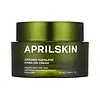What's inside
What's inside
 Key Ingredients
Key Ingredients

 Benefits
Benefits

 Concerns
Concerns

No concerns
 Ingredients Side-by-side
Ingredients Side-by-side

Artemisia Vulgaris Extract 80%
Skin ConditioningWater
Skin ConditioningSqualane 3%
EmollientMethylpropanediol
SolventGlycerin
Humectant1,2-Hexanediol
Skin ConditioningCoco-Caprylate/Caprate
EmollientSaccharide Hydrolysate
HumectantCetearyl Olivate
Ammonium Acryloyldimethyltaurate/Vp Copolymer
Niacinamide
SmoothingSorbitan Olivate
EmulsifyingButylene Glycol
HumectantTrehalose
HumectantEthylhexylglycerin
Skin ConditioningDipotassium Glycyrrhizate
HumectantAllantoin
Skin ConditioningOryza Sativa Bran Extract
Skin ConditioningCarbomer
Emulsion StabilisingXanthan Gum
EmulsifyingFructooligosaccharides
HumectantTromethamine
BufferingAdenosine
Skin ConditioningPullulan
Saccharum Officinarum Extract
MoisturisingSodium Hyaluronate
HumectantIndigofera Tinctoria Extract
MaskingHyaluronic Acid
HumectantMoringa Oleifera Seed Oil
EmollientSodium Hyaluronate Crosspolymer
HumectantHydrolyzed Sodium Hyaluronate
Skin ConditioningHydrolyzed Hyaluronic Acid
HumectantHemerocallis Fulva Flower Extract
Skin ConditioningCeramide NP
Skin ConditioningMyosotis Sylvatica Flower/Leaf/Stem Extract
Skin ConditioningPhytosphingosine
Skin ConditioningSodium Acetylated Hyaluronate
HumectantHydroxypropyltrimonium Hyaluronate
Hydrogenated Lecithin
EmulsifyingCI 75810
Cosmetic ColorantArtemisia Vulgaris Extract 80%, Water, Squalane 3%, Methylpropanediol, Glycerin, 1,2-Hexanediol, Coco-Caprylate/Caprate, Saccharide Hydrolysate, Cetearyl Olivate, Ammonium Acryloyldimethyltaurate/Vp Copolymer, Niacinamide, Sorbitan Olivate, Butylene Glycol, Trehalose, Ethylhexylglycerin, Dipotassium Glycyrrhizate, Allantoin, Oryza Sativa Bran Extract, Carbomer, Xanthan Gum, Fructooligosaccharides, Tromethamine, Adenosine, Pullulan, Saccharum Officinarum Extract, Sodium Hyaluronate, Indigofera Tinctoria Extract, Hyaluronic Acid, Moringa Oleifera Seed Oil, Sodium Hyaluronate Crosspolymer, Hydrolyzed Sodium Hyaluronate, Hydrolyzed Hyaluronic Acid, Hemerocallis Fulva Flower Extract, Ceramide NP, Myosotis Sylvatica Flower/Leaf/Stem Extract, Phytosphingosine, Sodium Acetylated Hyaluronate, Hydroxypropyltrimonium Hyaluronate, Hydrogenated Lecithin, CI 75810
Water
Skin ConditioningGlycerin
HumectantCaprylic/Capric Triglyceride
Masking1,2-Hexanediol
Skin ConditioningPanthenol
Skin ConditioningSimmondsia Chinensis Seed Oil
EmollientSodium Polyacrylate
AbsorbentRetinol
Skin ConditioningTocopheryl Acetate
AntioxidantSodium Hyaluronate
HumectantHydroxyacetophenone
AntioxidantPanax Ginseng Root Extract
EmollientPropanediol
SolventCamellia Sinensis Leaf Extract
AntimicrobialCaprylhydroxamic Acid
Rosa Damascena Flower Water
MaskingCucumis Sativus Fruit Extract
EmollientPropylene Glycol
HumectantChamomilla Recutita Flower Extract
MaskingAloe Barbadensis Leaf Juice
Skin ConditioningWater, Glycerin, Caprylic/Capric Triglyceride, 1,2-Hexanediol, Panthenol, Simmondsia Chinensis Seed Oil, Sodium Polyacrylate, Retinol, Tocopheryl Acetate, Sodium Hyaluronate, Hydroxyacetophenone, Panax Ginseng Root Extract, Propanediol, Camellia Sinensis Leaf Extract, Caprylhydroxamic Acid, Rosa Damascena Flower Water, Cucumis Sativus Fruit Extract, Propylene Glycol, Chamomilla Recutita Flower Extract, Aloe Barbadensis Leaf Juice
Ingredients Explained
These ingredients are found in both products.
Ingredients higher up in an ingredient list are typically present in a larger amount.
1,2-Hexanediol is a synthetic liquid and another multi-functional powerhouse.
It is a:
- Humectant, drawing moisture into the skin
- Emollient, helping to soften skin
- Solvent, dispersing and stabilizing formulas
- Preservative booster, enhancing the antimicrobial activity of other preservatives
Glycerin is already naturally found in your skin. It helps moisturize and protect your skin.
A study from 2016 found glycerin to be more effective as a humectant than AHAs and hyaluronic acid.
As a humectant, it helps the skin stay hydrated by pulling moisture to your skin. The low molecular weight of glycerin allows it to pull moisture into the deeper layers of your skin.
Hydrated skin improves your skin barrier; Your skin barrier helps protect against irritants and bacteria.
Glycerin has also been found to have antimicrobial and antiviral properties. Due to these properties, glycerin is often used in wound and burn treatments.
In cosmetics, glycerin is usually derived from plants such as soybean or palm. However, it can also be sourced from animals, such as tallow or animal fat.
This ingredient is organic, colorless, odorless, and non-toxic.
Glycerin is the name for this ingredient in American English. British English uses Glycerol/Glycerine.
Learn more about GlycerinSodium Hyaluronate is hyaluronic acid's salt form. It is commonly derived from the sodium salt of hyaluronic acid.
Like hyaluronic acid, it is great at holding water and acts as a humectant. This makes it a great skin hydrating ingredient.
Sodium Hyaluronate is naturally occurring in our bodies and is mostly found in eye fluid and joints.
These are some other common types of Hyaluronic Acid:
Learn more about Sodium HyaluronateWater. It's the most common cosmetic ingredient of all. You'll usually see it at the top of ingredient lists, meaning that it makes up the largest part of the product.
So why is it so popular? Water most often acts as a solvent - this means that it helps dissolve other ingredients into the formulation.
You'll also recognize water as that liquid we all need to stay alive. If you see this, drink a glass of water. Stay hydrated!
Learn more about Water